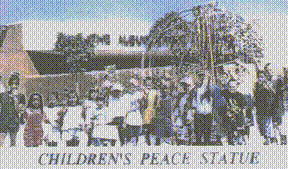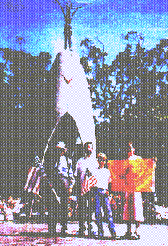We would like to appeal directly to your heart. A plan is being made to build a Peace Statue in the open plaza near the United Nations Building in New York, target date: Year 2000. A similar project has already been successfully completed in Albuquerque, NM
IF YOU CAN HELP IN NEW YORK, please send your comments, inquiries or news and development to the writer:
Mr. Yokoi Saburo
1-55-3 Yotserya Fruchu-shi
Toyko, Japan
Telephone: 0423-60-6335
or send an email message in care of prop1@prop1.org
CHILDREN'S PEACE STATUE MOVEMENT - HOW IT GREW, MET OBJECTIONS, AND WAS FINALLY COMPLETED (1990-1995)
HOW IT STARTED
It all started in the Arroyo-del-Oso elementary school in Albuquerque, New Mexico. The school's third, fourth and fifth graders started their campaign for the abolition of atomic weapons as they learned the issue was very important to protect their own lives. Their teachers were eager to teach the young students the meaning of peace and winning a through action. Luckily for the children, Camy Condon, a social activist and member of the Church Committee, lived nearby. Camy had spent 10 years in Japan when her husband was teaching at the International Christian University in Mitaka, Tokyo.
Camy knew about Hiroshima and was deeply impressed by the children's desire to do something for world peace. Camy suggested to the children about the building of a peace statue. It was to be the sister statue of the Genbaku-no-ko No Zo of Hiroshima.
 Arroyo-del-Oso is located in Albuquerque, a city known for its strong ties to the U.S. military. The state of New Mexico is located in the arid lands of the southwestern United States. It has a population of 1.4 million. Out of the 400,000 residents of Albuquerque, many work for military-related industries. Albuquerque is very close to the Los Alamos research facilities where atomic bombs were first assembled. I In the nearby areas are other strategic military facilities such as the Sandia Research Center, Kirtland Air Force Base, and huge underground storerooms for nuclear warheads.
The three people who participated in building the Children's Peace Statue in New Mexico, U.S.A., visited Hiroshima. The first thing they wanted to see was the Statue of Sadako, the symbol of peace and love of children. Sadako's statue is known in Japanese as the Genbaku-no-ko no Zo (the Statue of a Child Victim of Atomic Bombing). This statue inspired the children of New Mexico to build their own Peace Statue.
Travis (13 years old) came to Hiroshima representing some of the children who played an active role in building their statue. He spoke at the3 world conferences and many meetings. His message was short and clear. "Let's build many children's peace statues … not just here in Hiroshima but throughout the world. And let's all learn about peace."
Arroyo-del-Oso is located in Albuquerque, a city known for its strong ties to the U.S. military. The state of New Mexico is located in the arid lands of the southwestern United States. It has a population of 1.4 million. Out of the 400,000 residents of Albuquerque, many work for military-related industries. Albuquerque is very close to the Los Alamos research facilities where atomic bombs were first assembled. I In the nearby areas are other strategic military facilities such as the Sandia Research Center, Kirtland Air Force Base, and huge underground storerooms for nuclear warheads.
The three people who participated in building the Children's Peace Statue in New Mexico, U.S.A., visited Hiroshima. The first thing they wanted to see was the Statue of Sadako, the symbol of peace and love of children. Sadako's statue is known in Japanese as the Genbaku-no-ko no Zo (the Statue of a Child Victim of Atomic Bombing). This statue inspired the children of New Mexico to build their own Peace Statue.
Travis (13 years old) came to Hiroshima representing some of the children who played an active role in building their statue. He spoke at the3 world conferences and many meetings. His message was short and clear. "Let's build many children's peace statues … not just here in Hiroshima but throughout the world. And let's all learn about peace."
SPRING, 1990
The children's appeal for building a peace statue to symbolize their own survival quickly caught on. Child after child joined in the movement by donating a dollar each. Japanese school teachers encouraged the children's movement by sending them strings of Senba-Auru, or One Thousand Cranes, the symbol of peace. Musicians also joined in to aid the children in their quest.
The movement quickly spread to all parts of America and to 63 nations abroad. The site for erecting the statue was determined to be in Los Alamos, exactly where the first atomic bombs were created. The two bombs dropped over Hiroshima and Nagasaki were built in Los Alamos.
A nationwide design contest was held and over 300,000 children across the U.S. sent in their design concepts. It was the design of a Texas high-school student named Martinez that won the contest. The winning design and other children's designs were put on a nationwide tour and displayed in many cities across the United States.
NOVEMBER, 1994
There was a sudden setback in November, 1994. Some citizens of Los Alamos objected strongly to the children's project. These were the people who believed that atomic bombs helped to end the war early. They staged a bitter protest against erecting the statue in the Peace Garden, proposed to be built in Los Alamos. The U.S. Department of Energy put its pressure on the movement, they could not condone movements that were critical of nuclear policy. Some even made threats. The city council of Los Alamos met twice to discuss the site. The vote split 3 to 3, the council could not reach a unanimous decision.
The children, however, did not give up. Their eagerness and craving for peace was gradually affecting the grown-ups around them. Finally the Albuquerque City Museum gave the children the go sign!
JAUARY, 1995
The children's actions were started in full swing again. Vigorous campaigns were initiated with the number of donors reaching 90,000. A change was made to the statue's original design concept. Instead of being built by an artist, it was to be made by 3000 children! The children made wax models and put their names on the little animal statues they created. Then they were cast in bronze and the end result was a powerful artistic creation.
AUGUST 1, 1995
The statue was inaugurated with a tape-cutting ceremony, followed by a month of peace-promoting events sponsored by various organizations across the U.S. On August 1st Mayor Debbie Jaramillo of Santa Fe, New Mexico's state capital, hosted a ceremony. Accompanied by First Lady Ms. Dee Johnson in the ceremony, Ms. Jaramillo said, "Children are more mature than grown-ups. Peace is both the right and the obligation of each individual." (Translation) The mayor's message reverberated in many people's hearts
THE ROAD TO ABOLITION OF NUCLEAR WEAPONS
AMERICA'S NUCLEAR DEVELOPMENT IN FULL SWING
Anti-nuclear campaigns are picking up momentum daily. The pro-nuclear powers, however, are growing more ambitious and violent than ever. The U.S. media reports how the "nuclearization of space" is being promoted with strong backing from research done in the Albuquerque and Los Alamos area. The Los Alamos and Sandia research centers and Kirtland Air Force Base are known to be engaged in the development of LASER weapons.
Research was started this year on the development of super high-speed missiles, which can fly at speeds of forty thousand miles per hour. To everyone's great dismay, a huge reactor, using 65 kilograms of plutonium, was built just to generate heat. Since the Three Mile Island incident, no nuclear reactors have been built in the United States, but General Electric Co. has pushed the plutonium reactor project forward. When Mr. Clinton was reelected last autumn, he wasted no time in visiting Albuquerque. He might have asked Mayor Martin J. Chavez's cooperation in the development of atomic weapons.
Different nations have different approaches for banning nuclear weapons. They may be banned by law. For example the Proposition One campaign of Washington D.C. is directed towards an opportunity for modifying the Constitution to make it more peace-oriented. The Peace Statue movement by New Mexican children is an example of children's faith and power which eventually captured the hearts of adults.
In Hiroshima, Travis called for greater action. Let us hear in his words the true desires of millions and millions of children the world over. Let us promote the peace statue building movement. It will bring children of many countries together with a clear awareness that they want a peaceful, nuclear-free world.
We would like to appeal directly to your heart. A plan is being made to build another Peace Statue in the open plaza near the United Nations Building in New York. In Japan we are planning to build children's peace statue. Co-working with foreign countries, in Okinawa, Hiroshima and Nagasaki. Help the children around you to build their symbol of world peace. Join in the movement to raise peace statues in your local communities, in your country or other countries through international cooperation
Target date: Year 2000!
Send your comments, inquiries or news and development to the writer:
Mr. Yokoi Saburo
1-55-3 Yotserya Fruchu-shi
Toyko, Japan
Telephone: 0423-60-6335
You will be notified of scheduled address changes.

